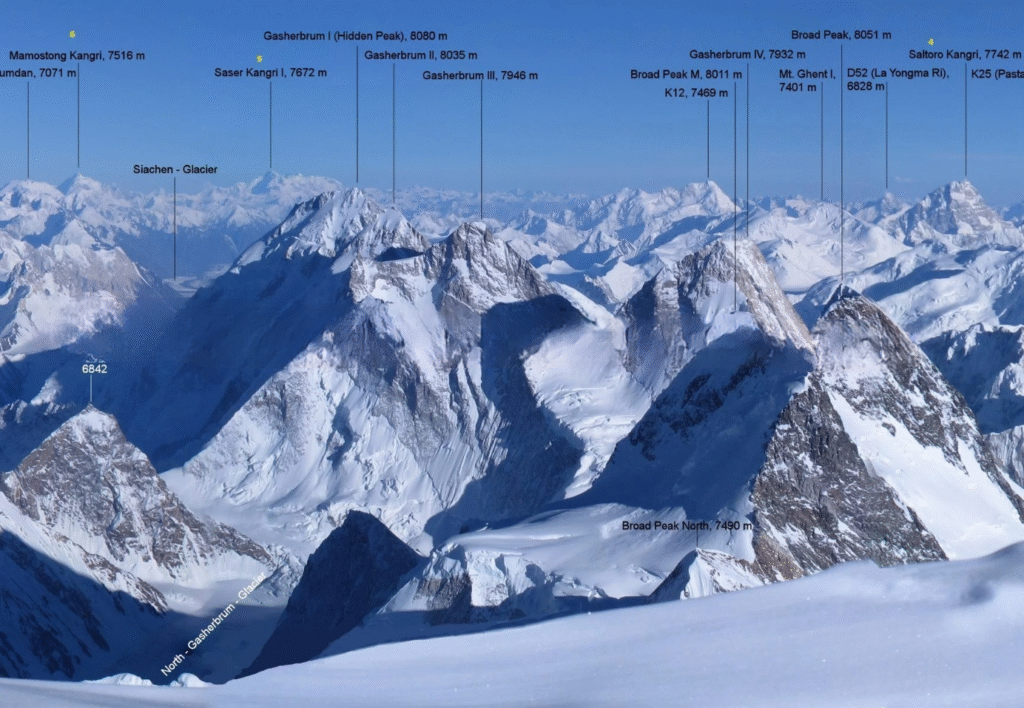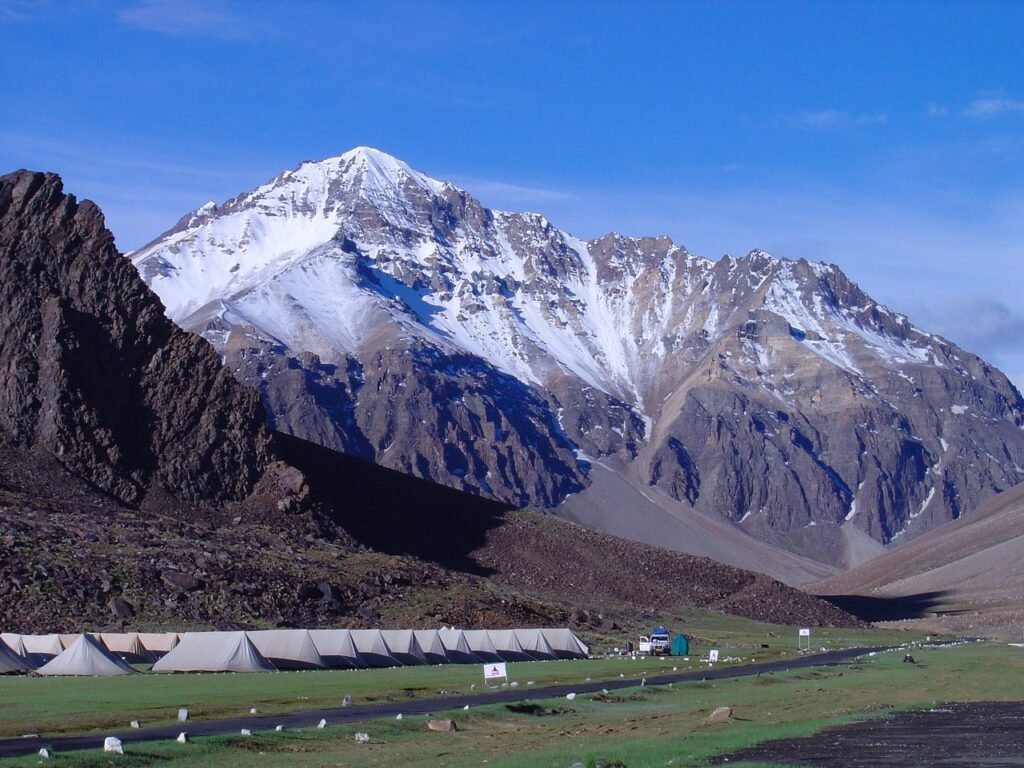Rimo I Mountain, also called Rimo Kangri I, is a remote and awe-inspiring Himalayan peak. Tucked in the heart of the eastern Karakoram Range, this mountain combines history, adventure, culture, and wild natural beauty into one of South Asia’s most incredible high-altitude destinations.
Rimo I stands as the highest peak (7,385 meters/24,229 feet) in the Rimo massif of northern Ladakh, India. Its sparsely visited slopes, icy grandeur, and strategic location near Siachen Glacier have made it an obsession for explorers, scientists, climbers, and environmentalists alike. “Rimo,” a Tibetan word, means “striped mountain”; its banded rock and snow faces dramatically confirm the name.
Geographic Location and Significance
- Rimo crowns the Rimo Muztagh subrange, encircled by the formidable glaciers of the eastern Karakoram.
- Coordinates: 35°21′21″N, 77°22′05″E, within India’s Ladakh region.
- Just 20 km from the snout of the Siachen Glacier and near the Nubra Valley, it lies in a geopolitically sensitive area between India, China, and Pakistan.
- Glaciers: Central Rimo, South Rimo, and North Terong glaciers all radiate from its massif, draining into the Shyok River.
Notable Characteristics and Height
- World’s 71st highest mountain, at 7,385 meters (24,229 feet).
- Prominence is 1,438 meters (4,718 feet), adding to its visual impact.
- Terrain: Steep ice faces, fractured ridgelines, rocky buttresses, and crevasse-riddled glaciers, making it both dangerous and untouched.
- Flanked by several other giants of the Karakoram, Mamostong Kangri, K12, Teram Kangri, and Saltoro Kangri are all within 50 km.
Key Details:
| Major Aspect | Detail/Value |
|---|---|
| Location | Rimo Muztagh, Karakoram Range, Ladakh, India (20 km NE of Siachen Glacier) |
| Elevation | 7,385 meters (24,229 feet) |
| Prominence | 1,429 meters (4,688 feet) |
| Coordinates | 35°21′21″N 77°22′05″E |
| Meaning | “Striped Mountain” (Tibetan origin) |
| Best Visiting Time | July to September (best climbing/trekking season) |
| Access/Route | Permit required; trek starts from Sasoma/Warshi (Nubra Valley), approach via Rimo Glacier; multiple days of trek to base camp |
| Difficulty | Highly technical, remote, physically and logistically demanding; requires advanced mountaineering skills |
| Permit/Regulation | Very restricted; requires permits and military clearance due to proximity to Siachen Glacier and sensitive border area |
| Trekking Costs | Expeditions cost varies: Trekking in Ladakh (general), US$1,470–1,622 per person (excluding airfare), group size dependent |
| Climbing History | First ascent by Indo-Japanese team, 1988; very few repeated ascents |
| Environment | Glaciated, extreme cold, avalanche/prone slopes, unpredictable weather |
Notes:
- Trekkers must be self-sufficient, as the region is remote and lacks infrastructure or rescue options.
- Costs depend on itinerary, group size, operator, and services. Actual Rimo I expeditions require more extensive logistical, permit, and expedition fees than standard Ladakh trekking tours.
- Because Rimo I sits in a restricted military zone, access is exceptional, and only a handful of expeditions have been permitted. Most trekkers and climbers will only reach the general Nubra Valley or adjoining peaks, less restricted than Rimo I.
A Journey Through History
Early Exploration
- It was little-known until the 20th century due to remoteness and political complications.
- The first Western explorers visited in 1914 (Filippo De Filippi) and 1929 (Philip and Jenny Visser).
- Its inaccessible beauty and proximity to trade routes like the Karakoram Pass gave the region a mythical status among travellers and traders.
First Ascents
- Rimo, I went unclimbed until July 28, 1988. The summit was reached by a rare Indo-Japanese expedition led by Hukam Singh (India) and Yoshio Ogata (Japan), through the southern approach.
- Earlier attempts by Indo-British (1985) and Indo-Australian (1986) teams failed due to technical and logistical obstacles.
- Since its first ascent, only a handful of expeditions have dared to attempt its summits because of severe restrictions and dangers.
Cultural Significance
- The Ladakh region, home of Rimo I, boasts a rich tapestry of Buddhist culture, ancient Himalayan villages, and unique traditions.
- Its presence near pilgrimage sites, high-altitude monasteries, and vibrant festivals ties Rimo I into the fabric of Ladakh’s spiritual and community life.
- Locals consider the mountains sacred and see them as protectors, woven into folk tales and traditions across generations.
Ecology and Wildlife
- Flora: Sparse yet hardy, alpine shrubs, mosses, lichens, and brief bursts of wildflowers during the short Ladakh summer.
- Fauna: Includes snow leopards, Himalayan brown bears, Tibetan wolves as apex predators, and unique birdlife like griffon vultures and golden eagles.
- The region is a biodiversity hotspot, resilient against extreme cold and low oxygen, making it an area of scientific fascination.
Trekking, Tourism, and Adventure
Trekking Route Overview
- Access: Highly restricted, requiring special permits and military clearance due to security sensitivities, as the area borders Siachen and is near the Chinese and Pakistani frontiers.
- Base Camp approach: Starts from Sasoma or Warshi villages in Nubra Valley, followed by several days of arduous trekking across glaciated and rocky terrain.
- Logistics: Expedition teams use local porters and pack animals and must be completely self-sufficient due to the lack of rescue infrastructure.
- There is no established trekking infrastructure for casual tourists; this region is reserved for elite expeditions and researchers.
Trekking Highlights
- Remote wilderness, surreal glacial scenery, and a sense of total isolation.
- Opportunity to observe unique wildlife and rare alpine plants in their native ecosystem.
- Experience Ladakhi culture in villages along approach routes.
- Nearness to historically significant trade routes (Karakoram Pass, Daulat Beg Oldi).

Climbing Rimo I: Details and Challenges
Difficulty and Terrain
- Technical proficiency in snow, ice, and mixed rock climbing is mandatory.
- Most common route: Southern approach via Rimo Glacier, navigating crevasses, unstable snowfields, and 50–70° angled faces.
- Glacial travel includes dangerous avalanches and crevasse hazards.
- The remoteness means extreme self-sufficiency is needed, with no outside rescue available.
Weather and Climate
- The best window for climbing is July–September, when the weather is relatively stable, but dangers still loom large.
- Typical summer high-altitude temperatures range from –22°C to –27°C; sudden blizzards, whiteouts, and temperature swings are common.
- Intense ultraviolet radiation and storm risk require full mountaineering preparedness.
The Strategic and Scientific Role of Rimo I
- Sits near vital glacial systems feeding the Shyok river, an essential resource for both ecological and geopolitical stability.
- The Siachen area, including Rimo I, is monitored closely by the Indian military.
- Scientific expeditions study glacial retreat, climate change, and high-altitude adaptation in this pristine wilderness.
Tourism Potential and Restrictions
- As of now, Rimo I is not open to mainstream tourism. Expeditions are rare and require sponsorship, extensive vetting, and military oversight.
- Debates continue about balancing conservation, military security, and eco-adventure. Proposals for a Siachen Peace Park have surfaced but are still in planning stages.
Travel and Permit Process
- Foreign and Indian citizens must obtain Inner Line Permits, Defence Ministry clearance, and local government authorisation to enter the Rimo region.
- Environmental stewardship is enforced, and a leave-no-trace ethic is strictly followed.
- Commercial trekking agencies may provide logistical support, but only for approved expeditions.
Recent News
In 2025, following rising awareness over glacier retreat and climate change, a coalition of Indian ecologists, Ladakhi cultural organisations, and international adventure societies petitioned the central government to declare Rimo I and the surrounding glacier systems as a special Himalayan wilderness preserve. The goal is to safeguard both its unique ecosystem and centuries-old cultural legacy while providing limited, managed access for research and high-profile adventure expeditions. Military leaders and environmental activists have opened a new dialogue about the future of this icy cathedral, balancing security with the imperative to protect one of South Asia’s last untouched summits. This bold move signals hope for Rimo I’s next century.
FAQs About Rimo I Mountain
Where is Rimo I located, and what is its elevation?
Rimo I is the highest summit in the Rimo massif of Ladakh, India, in the eastern Karakoram Mountains. Its elevation is 7,385 meters (24,229 feet).
When was Rimo I first successfully climbed?
The first successful ascent was achieved on July 28, 1988, by an Indo-Japanese expedition (led by Hukam Singh and Yoshio Ogata, with Nima Dorje Sherpa and Tsewang Samanla summiting).
What are the primary challenges in climbing Rimo I?
- Steep ice faces (up to 70° incline) and heavily crevassed glaciers require advanced technical skill.
- In a remote location, complete self-sufficiency is crucial, and there is no hope of rescue in emergencies.
- Extreme weather: -22°C to -27°C is typical even in summer, with storms frequent.
- Complicated logistics and the need for military permits further increase the challenge.
Is Rimo I open for trekking, and how can one access it?
No, the region around Rimo I is restricted; only sanctioned mountaineering expeditions may enter with special permits. The trek to base camp is among the toughest in the Himalayas.
What is unique about the flora and fauna around Rimo I?
- The region supports rare and highly adapted wildlife like snow leopards, Tibetan wolves, and Himalayan brown bears alongside tough alpine plants.
- This delicate high-altitude ecosystem highlights the resilience of life under extreme conditions.
Why is Rimo I strategically and scientifically important?
- Its glaciers feed critical water sources for downstream populations and ecosystems.
- Sits close to several international borders, making it of high strategic military significance to India.
- Scientists study its glaciers for climate data, and its extreme environment offers insight into survival at the edge of human capability.
Are there any cultural attractions or local experiences in the Rimo area?
While access to Rimo I itself is restricted, the surrounding Ladakh region is rich in Buddhist heritage, monasteries, sacred lakes, and vibrant festivals. Cultural tourism flourishes in Nubra Valley and Leh.

